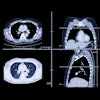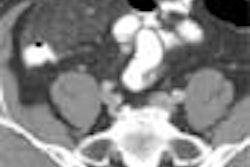With the help of dual-energy CT technology, researchers at the Mayo Clinic in Rochester, MN, have taken the first steps toward distinguishing iron from calcium deposits in coronary arteries, potentially enabling the differentiation of hemorrhagic from calcific plaque.
Unstable plaque is characterized by intraplaque hemorrhage and subsequent iron deposits. It is that unstable plaque that is more likely to break from an artery wall and trigger a potentially fatal blood clot.
In conventional CT, both iron- and calcium-based images appear similarly bright. In dual-energy CT, CT values of different elements change disproportionately as a function of x-ray energy.
"It is that physics phenomenon that we want to exploit to help us discriminate materials of atomic number that are very similar to one another, such as calcium and iron," said Cynthia H. McCollough, Ph.D., of the Mayo Clinic. "This presents the opportunity to potentially differentiate calcium and iron in atherosclerotic plaque."
The research was supported, in part, by grants from the National Institutes of Health (NIH) and from the Mayo Foundation. In addition, Malvern, PA-based Siemens Medical Solutions provided its dual-energy CT scanner and the work-in-progress imaging software.
McCollough detailed the research results at the 2006 American Heart Association (AHA) conference in Chicago in November.
The protocol
The protocol to help determine the feasibility of differentiating between iron and calcium included seven vials of solutions placed in an acrylic phantom. One vial contained pure water, another held pure iron, and a third contained pure calcium. The remaining four vials contained various, mixed amounts of iron, calcium, and water. The vials were imaged at 80 and 140 kV on a dual-source 64-slice CT scanner. A linear combination of the 80 and 140 kV images was then created to cancel the calcium signal.
A three-material decomposition algorithm developed in conjunction with Siemens was additionally applied to the 80 and 140 kV images, using changes in CT numbers between the two energy settings to differentiate the materials. Color was assigned according to CT value changes between 80 and 140 kV and a color-mapped, dual-energy image was used to show material composition.
Researchers found that pure calcium was very bright in the individual 80 and 140 kV images, but in the dual-energy subtraction image, the pixel value was essentially zero, demonstrating the ability to cancel calcium signal. The dual-energy value of pure iron was twice that of the 50%/50% iron/calcium mixture, while the iron/water and the iron/calcium/water solutions were the appropriate weighted average of the solution components.
McCollough noted that noise reduction is needed during postprocessing for dual-energy combinations, and to develop more stable calibration phantoms.
Encouraging results
"Dual-energy CT does appear feasible for the discrimination of iron and calcium, potentially allowing the differentiation between hemorrhagic and calcific plaque, both of which appear bright on single-energy CT," McCollough concluded. "This may allow for noninvasive detection of unstable plaques in people."
A key piece of data the researchers are looking to develop is "a signature of whether there is an iron or hemorrhagic component in a plaque," she added. "In the color-coded or the calcium-removed image, if something shows that there is iron content, then that plaque is not just calcified plaque, which may allow physicians to differentiate stable versus vulnerable plaques."
McCollough added that the study has expanded its phantom research into explanted diseased hearts and soon will begin in vivo animal studies.
By Wayne Forrest
AuntMinnie.com staff writer
January 15, 2007
Related Reading
Inflammatory view: Imaging blind to plaque risk, December 7, 2006
Dual-source imaging promises better CT scanning, June 15, 2006
Cardiac imaging dazzles, but radiologists can't compete alone, April 10, 2006
Siemens launches new dual-source CT technology, November 17, 2005
Copyright © 2007 AuntMinnie.com




















